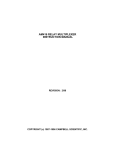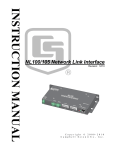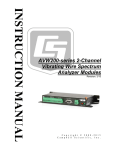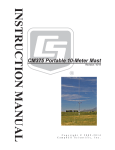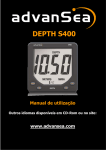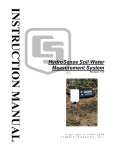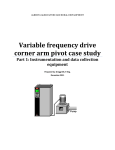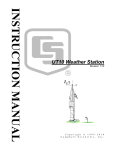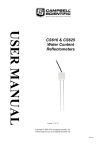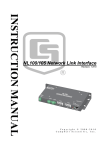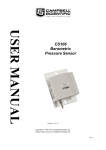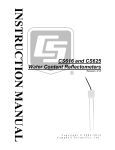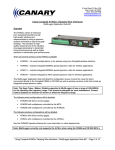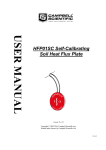Download AM16/32B Relay Analogue Multiplexer
Transcript
AM16/32B Relay Analogue Multiplexer Issued: 23.4.13 Copyright © 1987-2013 Campbell Scientific, Inc. Printed under licence by Campbell Scientific Ltd. CSL 760 Guarantee This equipment is guaranteed against defects in materials and workmanship. This guarantee applies for twelve months from date of delivery. We will repair or replace products which prove to be defective during the guarantee period provided they are returned to us prepaid. The guarantee will not apply to: • Equipment which has been modified or altered in any way without the written permission of Campbell Scientific • Batteries • Any product which has been subjected to misuse, neglect, acts of God or damage in transit. Campbell Scientific will return guaranteed equipment by surface carrier prepaid. Campbell Scientific will not reimburse the claimant for costs incurred in removing and/or reinstalling equipment. This guarantee and the Company’s obligation thereunder is in lieu of all other guarantees, expressed or implied, including those of suitability and fitness for a particular purpose. Campbell Scientific is not liable for consequential damage. Please inform us before returning equipment and obtain a Repair Reference Number whether the repair is under guarantee or not. Please state the faults as clearly as possible, and if the product is out of the guarantee period it should be accompanied by a purchase order. Quotations for repairs can be given on request. It is the policy of Campbell Scientific to protect the health of its employees and provide a safe working environment, in support of this policy a “Declaration of Hazardous Material and Decontamination” form will be issued for completion. When returning equipment, the Repair Reference Number must be clearly marked on the outside of the package. Complete the “Declaration of Hazardous Material and Decontamination” form and ensure a completed copy is returned with your goods. Please note your Repair may not be processed if you do not include a copy of this form and Campbell Scientific Ltd reserves the right to return goods at the customers’ expense. Note that goods sent air freight are subject to Customs clearance fees which Campbell Scientific will charge to customers. In many cases, these charges are greater than the cost of the repair. Campbell Scientific Ltd, Campbell Park, 80 Hathern Road, Shepshed, Loughborough, LE12 9GX, UK Tel: +44 (0) 1509 601141 Fax: +44 (0) 1509 601091 Email: [email protected] www.campbellsci.co.uk PLEASE READ FIRST About this manual Please note that this manual was originally produced by Campbell Scientific Inc. primarily for the North American market. Some spellings, weights and measures may reflect this origin. Some useful conversion factors: Area: 1 in2 (square inch) = 645 mm2 Length: 1 in. (inch) = 25.4 mm 1 ft (foot) = 304.8 mm 1 yard = 0.914 m 1 mile = 1.609 km Mass: 1 oz. (ounce) = 28.35 g 1 lb (pound weight) = 0.454 kg Pressure: 1 psi (lb/in2) = 68.95 mb Volume: 1 UK pint = 568.3 ml 1 UK gallon = 4.546 litres 1 US gallon = 3.785 litres In addition, while most of the information in the manual is correct for all countries, certain information is specific to the North American market and so may not be applicable to European users. Differences include the U.S standard external power supply details where some information (for example the AC transformer input voltage) will not be applicable for British/European use. Please note, however, that when a power supply adapter is ordered it will be suitable for use in your country. Reference to some radio transmitters, digital cell phones and aerials may also not be applicable according to your locality. Some brackets, shields and enclosure options, including wiring, are not sold as standard items in the European market; in some cases alternatives are offered. Details of the alternatives will be covered in separate manuals. Part numbers prefixed with a “#” symbol are special order parts for use with non-EU variants or for special installations. Please quote the full part number with the # when ordering. Recycling information At the end of this product’s life it should not be put in commercial or domestic refuse but sent for recycling. Any batteries contained within the product or used during the products life should be removed from the product and also be sent to an appropriate recycling facility. Campbell Scientific Ltd can advise on the recycling of the equipment and in some cases arrange collection and the correct disposal of it, although charges may apply for some items or territories. For further advice or support, please contact Campbell Scientific Ltd, or your local agent. Campbell Scientific Ltd, Campbell Park, 80 Hathern Road, Shepshed, Loughborough, LE12 9GX, UK Tel: +44 (0) 1509 601141 Fax: +44 (0) 1509 601091 Email: [email protected] www.campbellsci.co.uk Contents PDF viewers: These page numbers refer to the printed version of this document. Use the PDF reader bookmarks tab for links to specific sections. 1. Function ...................................................................... 1 1.1 1.2 Typical Applications .............................................................................. 1 Compatibility.......................................................................................... 2 2. Physical Description .................................................. 2 3. AM16/32B Specifications ........................................... 3 4. Operation ..................................................................... 5 4.1 The Control Terminals ........................................................................... 5 4.1.1 Reset ................................................................................................ 6 4.1.2 Clock ............................................................................................... 6 4.1.2.1 Mode A ................................................................................ 7 4.1.2.2 Mode B ................................................................................. 7 4.1.2.3 Datalogger Connection/Instruction ..................................... 8 4.1.3 Ground ............................................................................................ 9 4.1.4 Power Supply .................................................................................. 9 4.2 Measurement Terminals....................................................................... 10 4.2.1 COM Terminals ............................................................................ 10 4.2.2 Sensor Input Terminals ................................................................. 11 5. Datalogger Programming......................................... 11 5.1 CRBasic Programming ........................................................................ 12 5.1.1 CR1000, CR800, and CR850 Programming ................................ 14 5.1.2 CR5000 and CR3000 Programming ............................................ 15 5.2 Edlog Programming ............................................................................. 16 5.2.1 Single Loop Instruction Sequence ................................................ 16 5.2.2 Multiple Loop Instruction Sequence ............................................ 22 5.3 General Programming Considerations................................................. 24 6. Sensor Hookup and Measurement Examples ........ 24 6.1 6.2 6.3 Single-Ended Analogue Measurement without Sensor Excitation ..... 25 Differential Analogue Measurement without Sensor Excitation ........ 25 Half Bridge Measurements .................................................................. 26 6.3.1 Half Bridge Measurement with Completion Resistor at Datalogger ................................................................................. 26 6.3.2 Potentiometer Measurement ......................................................... 27 6.3.3 Four Wire Half Bridge (Measured Excitation Current) ............... 27 6.4 Full Bridge Measurements ................................................................... 28 6.5 Full Bridges with Excitation Compensation ....................................... 29 i Thermocouple Measurement ...............................................................30 6.6.1 Measurement Considerations .......................................................30 6.6.2 Single-ended Thermocouple Measurement..................................32 6.6.3 Differential Thermocouple Measurement ....................................33 6.7 Mixed Sensor Types.............................................................................33 6.7.1 Mixed Sensor Example: Soil Moisture Blocks and Thermocouples ..........................................................................33 6.6 7. General Measurement Considerations ................... 37 8. Installation ................................................................. 37 8.1 8.2 Mounting Tabs .....................................................................................37 Controlling Humidity ...........................................................................38 Appendix A. AM16/32B Improvements ....................................... A-1 Figures 2-1. 3-1. AM16/32B Relay Multiplexer ...............................................................3 AM16/32B relay actuation time vs. temperature and battery voltage.................................................................................................5 4-1. AM16/32B to datalogger power/control hookup using CABLE4CBL cable ............................................................................6 4-2. Diagram showing advancement of channels using clocking Mode B ...............................................................................................8 4-3. Power and ground connections for external power supply .................10 4-4. Typical AM16/32B to datalogger signal hookup (4x16 mode) using CABLE4CBL cable ................................................................11 5-1. SCWin (Short Cut for Windows program builder) .............................12 5-2. Example “4x16” mode program loops for CR23X, CR10(X), 21X, and CR7 dataloggers ...............................................................19 5-3. Example “2x32” mode program loops for CR23X, CR10(X), 21X, and CR7 dataloggers ...............................................................21 5-4. Wiring diagram for strain gauges and potentiometers (uses two CABLE4CBL cables) .......................................................................22 6-1. Single-ended measurement without excitation ....................................25 6-2. Differential measurement without excitation ......................................25 6-3. Half bridge (modified 107 Temperature Probe) hookup and measurement .....................................................................................26 6-4. Potentiometer hookup and measurement (using CABLE4CBL cable).................................................................................................27 6-5. Four wire half bridge hookup and measurement .................................28 6-6. Full bridge measurement......................................................................28 6-7. Full bridge measurement with excitation compensation .....................29 6-8. Differential thermocouple measurement with reference junction at the datalogger................................................................................31 6-9. Differential thermocouple measurement with reference junction at the AM16/32B ..............................................................................31 6-10. AM16/32B aluminium cover plate ......................................................32 ii 6-11. Thermocouple and soil block measurement for CR10X example ...... 34 8-1. Mounting tab hole pattern .................................................................... 38 Table 5-1. Single Loop Instruction Sequence ....................................................... 16 iii iv Cautionary Notes The AM16/32B is not designed to multiplex power. Its intended function is to switch low level analogue signals. Switched currents in excess of 30 mA will degrade the relay contacts involved, rendering that channel unsuitable for further low level analogue measurement. Customers who need to switch power are directed to Campbell Scientific’s SDM-CD16AC, A6REL-12, or A21REL-12 relays. Changing the setting of the mode switch from “4x16” to “2x32” connects COM ODD H to COM EVEN H and also COM ODD L to COM EVEN L. After wiring AM16/32B, exercise due care to avoid inadvertently putting excess voltage on a line or short circuiting a power supply which might damage connected devices such as datalogger, wiring panel, sensor, or multiplexer (not covered under warranty). v vi AM16/32B Relay Multiplexer 1. Function The primary function of the AM16/32B Multiplexer is to increase the number of sensors that can be measured by a CR1000, CR3000, CR800, CR850, CR23X, CR10(X), 21X, or CR7 datalogger. The AM16/32B is positioned between the sensors and the datalogger. The AM16/32B is a replacement for Campbell Scientific’s AM16/32A model. The hardware is the same as the AM16/32A model. The AM16/32B adds a mode to address an individual relay. Mechanical relays in the AM16/32B connect each of the sensor channels in turn to a common output destined for the datalogger. The user program advances the multiplexer through the sensor channels making measurements and storing data. A slide switch located on the AM16/32B’s top panel selects one of two modes of operation. In “2x32” mode the multiplexer can scan 32 sensor input channels, each with two lines. In “4x16” mode it can scan 16 input channels with four lines a piece. The datalogger program is written according to the selected mode and the sensors to be measured. The maximum number of sensors that can be multiplexed by an AM16/32B depends primarily on the type(s) of sensors to be scanned. The following guidelines assume identical sensors: Up to 32 single-ended or differential analogue sensors that do not require excitation. For example: pyranometers and thermocouples (see Section 6.1, Single-Ended Analogue Measurement without Sensor Excitation, Section 6.2, Differential Analogue Measurement without Sensor Excitation, and Section 6.6, Thermocouple Measurement). Up to 32 single-ended sensors that require excitation. Example: some half bridges (see Section 6.3.1, Half Bridge Measurement with Completion Resistor at Datalogger). Up to 16 single-ended or differential sensors that require excitation. Examples: full bridges and four-wire half bridge with measured excitation (see Section 6.3.3, Four Wire Half Bridge, and Section 6.4, Full Bridge Measurements). In conjunction with a second AM16/32B, up to 16 six-wire full bridges (Section 6.5, Full Bridges with Excitation Compensation). 1.1 Typical Applications The AM16/32B is intended for use in applications where the number of required sensors exceeds the number of datalogger input channels. Most commonly, the AM16/32B is used to multiplex analogue sensor signals, although it can also be used to multiplex switched excitations, continuous analogue outputs, or even certain pulse counting measurements (those that require only intermittent sampling). It is also possible to multiplex sensors of different, but compatible, types (for example, thermocouples and soil moisture blocks, see Section 6.7.1, Mixed Sensor Example: Soil Moisture Blocks and Thermocouples). 1 AM16/32B Relay Multiplexer NOTE For a discussion of single-ended versus differential analogue measurements, please consult the measurement section of your datalogger manual. As purchased, the AM16/32B is intended for use in indoor, non-condensing environments. An enclosure is required for field or high humidity use. In applications where one or two multiplexers are deployed, the ENC10/12 (10” x 12”) enclosure is recommended. 1.2 Compatibility The AM16/32B is compatible with Campbell’s CR5000, CR800, CR850, CR3000, CR1000, CR23X, CR10(X), 21X, and CR7 dataloggers. The AM16/32B is compatible with a wide variety of commercially available sensors. As long as relay contact current maximums are not exceeded (see Cautionary Notes, page v), and no more than four lines are switched at a time, system compatibility for a specific sensor is determined by sensor-datalogger compatibility. In CR1000, CR800, CR850, CR3000, CR23X, and CR10(X) applications, the AM16/32B may be used to multiplex up to 16 Geokon vibrating wire sensors through one AVW1 vibrating wire interface. The AM16/32B can also be used to multiplex vibrating wire sensors connected to the AVW200 or AVW206. 2. Physical Description The AM16/32B is housed in a 10.2 x 23.9 x 4.6 cm (4.0 x 9.4 x 1.8 in) anodized aluminium case (Figure 2-1). The aluminium case is intended to reduce temperature gradients across the AM16/32B’s terminal strips. An aluminium cover plate is also included to this end, and its use is extremely important if thermocouples are being multiplexed (Section 6.6, Thermocouple Measurement). The case can be opened for inspection/cleaning by removing two Phillips-head screws located on the underside of the case. Mounting tabs are provided so the AM16/32B can be fastened to a flat surface or an enclosure plate (Section 8, Installation). All connections to the AM16/32B are made on the top panel terminal blocks. The island of four terminals located near the mode switch are dedicated to the connecting of datalogger power and control lines (Section 4.1, The Control Terminals). The four ODD and EVEN COM terminals on the other side of the mode switch carry shielded multiplexed sensor signals destined for datalogger analogue inputs. The remaining terminals on the AM16/32B are for sensor and sensor shield connection (Section 4.2, Measurement Terminals). All of the inputs of the AM16/32B are protected with gas tubes. The terminals accept stripped and tinned lead wires up to 16 AWG or 1.6 mm in diameter. Datalogger-toAM16/32B cabling requires a minimum of six and as many as nine individually insulated wires with shields. 2 User Manual Figure 2-1. AM16/32B Relay Multiplexer 3. AM16/32B Specifications Power*: Minimum Operating Voltage: Current Drain Quiescent: Active: Unregulated 12 Vdc from –55° to +40°C = 11.3 Vdc from +40° to +85°C = 11.8 Vdc (See Figure 3-1 for relay actuation times vs. temperature and supply voltage.) <210 µA 6 mA typical in “2 x 32” mode 11 mA typical in “4 x 16” mode Reset*: A continuous signal between 3.3 Vdc and 8 Vdc holds the AM16/32B in an active state (where a clock pulse can trigger a channel advance). A signal voltage <0.9 Vdc deactivates the AM16/32B (clock pulse will not trigger a scan advance; AM16/32B is also reset). Clock*: On the transition from <1.5 V to >3.3 V, a scan advance is actuated on the leading edge of the clock signal; clock pulse should be a minimum of 1 ms wide; maximum voltage is 8 Vdc. Operational Temperature Standard: Extended: –25° to +50°C –55° to +85°C Operational Humidity: 0 to 95%, non-condensing Dimensions Length: Width: Depth: 23.9 cm (9.4 in) 10.2 cm (4.0 in) 4.6 cm (1.8 in) 3 AM16/32B Relay Multiplexer Weight: Mounting Tab Hole Spacing: 693 g (1.5 lb) (approx.) 1 x 3 x 9 in. Up to 1/8 in or 3 mm diameter screws (see Figure 8-1). Expandability** (nominal): 2 AM16/32Bs per CR800/CR850 4 AM16/32Bs per CR3000 4 AM16/32Bs per CR5000 4 AM16/32Bs per CR1000 4 AM16/32Bs per CR23X 4 AM16/32Bs per CR10(X) 4 AM16/32Bs per 21X 8 AM16/32Bs per CR7 725 Card Maximum Cable Length: Maximum Switching Current***: Contact Specifications Initial contact resistance: Initial contact bounce: Contact material: Wiper to N.O. contact capacitance: Typical low-current (<30 mA) life: Relay Switching Thermal emf: Depends on sensor and scan rate. In general, longer lead lengths necessitate longer measurement delays. Refer to datalogger manual for details. 500 mA <0.1 ohm max. <1 ms Gold clad silver alloy 0.5 pF 5 x 107 operations 0.3 µV typical; 0.5 µV maximum Characteristics (applying 11.3 – 14 Vdc) Operate time: <10 ms over temperature and supply ranges Break-before-make guaranteed by design. Relays disengage from previous selected channel before engaging next channel. ESD Air Discharge: Contact Discharge: Surge: complies with IEC61000-4-2, test level 4 (±15 kV) complies with IEC61000-4-2, test level 4 (±8 kV) Complies with IEC61000-4-5, test level 3 (±2 kV, 2 ohms coupling impedance) * Reset and clock protected by 8V varistors; +12V input is protected by +16V transzorb. ** Assumes sequential activation of multiplexers and that each datalogger channel is uniquely dedicated. If your application requires additional multiplexing capability, please consult Campbell Scientific for application assistance. *** Switching currents greater than 30 mA (occasional 50 mA current is acceptable) will degrade the contact surfaces of the mechanical relays (increase their resistance). This will adversely affect the suitability of these relays to multiplex low voltage signals. Although a relay used in this manner no longer qualifies for low voltage measurement, it continues to be useful for switching currents in excess of 30 mA. 4 User Manual 10.0 8.0 6.0 4.0 16 17.3 15.6 16.9 15.2 16.5 14.8 16.1 14 15.3 14.4 15.7 13.6 14.9 13.2 14.5 12.8 14.1 12 13.3 12.4 13.7 11.6 12.9 11.2 12.5 10.8 12.1 11.7 10.4 0.0 11.3 10 2.0 10.9 9.6 RELAY ACTUATION TIME (ms) 12.0 POWER SUPPLY VOLTAGE 65C 50C 25C -25C Figure 3-1. AM16/32B relay actuation time vs. temperature and battery voltage 4. Operation Section 4.1, The Control Terminals, discusses the terminals that control operation of the multiplexer. These terminals are located at the left-hand side of the multiplexer as shown in Figure 2-1. Section 4.2, Measurement Terminals, discusses the use of sensor measurement terminals. 4.1 The Control Terminals The CABLE4CBL cable is used to connect the control terminals. The CR5000, CR3000, CR800, CR850, CR1000, CR23X, CR10(X), 21X, and CR7 dataloggers connect to the AM16/32B as shown in Figure 4-1 (“4x16” mode). Figure 4-1 depicts control connections. Measurement connections are discussed in Section 6, Sensor Hookup and Measurement Examples. The power, ground, reset, and clock connections remain essentially the same regardless of datalogger used. With the CR5000, CR3000, CR800, CR850, CR1000, CR23X, and CR10(X), the datalogger 12 Vdc supply and ground terminals are connected to the AM16/32B 12V and ground terminals. One control port is required for clocking and a second control port for reset. The cable’s shield is grounded on both ends as illustrated in Figure 4-1. 5 AM16/32B Relay Multiplexer CR800, CR850 CR10X, CR3000, CR1000 G G CR10X CABLE MUXPOWER SHIELD G 12V GND CLK 12 V 12V RES CR23X GG CR5000 12V 12 V12V G G G CR23X, CR5000 21X 12+12V V 21X CR7 +1212V V 12 V CR7 G N O C1-C8 EXCIT 1-4 EXCIT C1-C8 C1-C8 EXCITATION C1-C4 C1-C8C1-C8 1-4 EXCITATION C1-C8 C1-C6 C1-C8 C1-C8 C1-C4 C1-C8C1-C8 725 Card C1-C8 Control 725 Card Control Figure 4-1. AM16/32B to datalogger power/control hookup using CABLE4CBL cable With the 21X or CR7, the AM16/32B connects to the 12 Vdc and “ ” terminals for power. One control port is used for reset, and one switched excitation channel is used for clock (on 725 card with CR7). If a switched excitation port is not available, an additional control port can be used to provide clock pulses to the multiplexer. 4.1.1 Reset The reset (“RES”) line is used to activate the AM16/32B. A signal in the range of +3.3 to +8 Vdc applied to the reset terminal activates the multiplexer. When this line drops lower than +0.9 Vdc, the multiplexer enters a quiescent, low-currentdrain state. In the quiescent state, the common (COM) terminals are electrically disconnected from all of the sensor input channels. Reset should always connect to a datalogger control port. The CR800, CR850, CR3000, CR5000, and CR1000 use the PortSet() instruction to control the reset line. Instruction Do (P86) (option code 41 – 48 to activate, and 51 – 58 to deactivate) is generally used to activate/deactivate the multiplexer when using an Edlog datalogger; however, in the case of the 21X or CR7 with older PROMS, instruction Set Port (P20) is commonly used. 4.1.2 Clock Pulsing the AM16/32B “CLK” line high (“RES” line already high) advances the channel. The voltage level must fall below 1.5 Vdc and then rise above 3.3 Vdc to clock the multiplexer. The AM16/32B operates in one of two clocking modes: Mode A—sequentially advances through each relay channel (as long as RESET is HI, relays are closed on each rising CLK edge). A more detailed description of Mode A is provided in Section 4.1.2.1, Mode A. Mode B—uses a relay address to go directly to a specific channel (see Figure 4-2). This reduces power consumption and wear on the relay switches. When multiple sensor types are connected to the AM16/32B, Mode B allows one sensor type to be measured more frequently than the other sensor types. A more detailed description of Mode B is provided in Section 4.1.2.2, Mode B. 6 User Manual The AM16/32B detects a certain sequence on the RESET and CLK inputs to determine if it should operate in Mode A or Mode B; it does this every time the RESET line goes from LO to HI. 4.1.2.1 Mode A The AM16/32B operates in Mode A under the following circumstances: • • RESET HI for more than 9 ms. A CLK pulse occurs while RESET is HI. When reset first goes high, the COM terminals (ODD H, ODD L and EVEN H, EVEN L) are disconnected from all sensor input terminals. When the first clock pulse arrives, the COM terminals are switched to connect with sensor input channel 1 (blue lettering) consisting of 1H, 1L, 2H, and 2L. When a second clock pulse arrives, the common lines are switched to connect to channel 2 (3H, 3L, 4H, 4L). The multiplexer advances on the leading edge of the positive going clock pulse. NOTE The CLK pulse should be at least 1 ms long. A delay (typically 10 to 20 ms) is inserted between the beginning of the CLK pulse and the measurement instruction to ensure sufficient settling time to relay contacts. 4.1.2.2 Mode B To go into Mode B, the RES line must be set HI for 5 ms (±1 ms) without any clocking; then, the RES line needs to be set LO. After the RESET has been set low, the AM16/32B counts the number of CLK pulses that occur before the RES line is activated again. This number is the relay address. After getting into Mode B, the rising edge of RESET (<75 ms after last CLK pulse) activates the addressed relay. Once the addressed relay is activated, the AM16/32B advances to the next relay with each CLK pulse (see Figure 4-2). NOTE If the time between the falling edge of the 5 ms RESET pulse and the next rising edge of RESET or CLK is longer than 125 ms, the AM16/32B will go into Mode A. Section 4.1.2.3, Datalogger Connection/Instruction, includes a portion of a CR1000 program that shows the instructions used to go into Mode B and jump to channel 6. 7 AM16/32B Relay Multiplexer 5 ms (±1 ms) (0 -–100m 75 ms) mss the (0 s) Note: No te:ifif>>125 100m th e B B Address Add ress mode m ode is Aborted. mss Abo rted. Also, Also, Abort Abortcan canhappen happ enifif>>125 100m time tim ebetween b etw eenClk’s. Clk's 5m s (+-2m s) To Enter B T o Enter B Address Mode Address M ode Reset > 1m s Clk > 1m s En ters B addressing m o de Address=Chan 3 Chan 3 Selected (Relays m ake co ntact) Ad vance to Chan 4 (Relays m akes contact) Note: if th e B m od e is aborted, th en this event w ou ld select Mux Chan 1 Figure 4-2. Diagram showing advancement of channels using clocking Mode B 4.1.2.3 Datalogger Connection/Instruction With the 21X and CR7 dataloggers, switched excitation is generally used to clock the multiplexer (instruction Excitation with Delay (P22) configured for 5000 mV excitation). If no switched excitation channel is available, it is possible to clock using control ports. See Section 5.1, CRBasic Programming, for details. In the case of the CR5000, CR3000, CR800, CR850, CR1000, CR23X, and CR10(X), a control port is generally used to clock the multiplexer. Instruction Do (P86) with the pulse port option (command code 71 through 78) generates a 10 ms pulse which works well. The CR5000, CR3000, CR800, CR850, and CR1000 uses a control port controlled by PortSet(), Delay(), and SubScan()/NextSubScan to create the Clock pulses (see program example in Section 5.3, General Programming Considerations). If several multiplexers are required, a CR5000, CR3000, CR800, CR850, CR1000, CR10(X), or CR23X control port can source sufficient current to drive up to six AM16/32B CLK or RES inputs wired in parallel. ' ***** ' "Jump" AM16/32B directly to Channel 6 Scan (100,mSec,0,1) PortSet(5,1) 'Raise Reset line Delay (0,5,mSec) 'Keep reset HI for 5 ms PortSet(5,0) 'Reset line set LO (enters "B Addressing" mode) Delay (0,3,mSec) For i = 1 To 6 'Pulse CLK line 6 times - addresses Channel 6 PortSet(6,1) 'Raise CLK Delay (0,10,mSec) PortSet(6,0) 'Drop CLK Delay (0,10,mSec) Next i Delay (0,5,mSec) PortSet(5,1) 'Raise Reset - selects Channel 6 (relays make contact) NextScan 8 User Manual 4.1.3 Ground The AM16/32B has a ground lug that should be connected to earth ground via an 8 AWG wire. This connection should be as short as possible. The ground lug provides a path to dissipate surges that might propagate on a sensor’s shield line. An 8-V, bi-polar transzorb connects shield ground to the ground lug. The AM16/32B “GND” terminal is connected to datalogger power ground. The AM16/32B “GND” terminal is also connected to the CABLE4CBL’s SHIELD and, via that, to datalogger power ground (see Figure 4-1). If a separate power supply is used, the AM16/32B ground should also connect to the separate supply’s ground (Figure 4-3). An AM16/32B COM terminal should connect to a datalogger ground terminal (“ ” or “G”) via the cable that connects the COM terminals (see Section 4.2.1, COM Terminals, and Figure 4-4). The datalogger must connect to earth ground by one of the methods described in the installation and maintenance section of your datalogger operator’s manual. 4.1.4 Power Supply The AM16/32B requires a continuous 12 Vdc power supply for operation. The multiplexer’s current drain is less than 210 microamps in the quiescent state and is typically 6 to 11 milliamps at 12 Vdc when active (see current drain spec). The power supply is connected to the multiplexer terminals labelled “12V” (+) and “GND”. Connect the “GND” wire first for safety. In many applications, it is convenient to power the AM16/32B from a datalogger battery. For more power-intensive applications, an external, rechargeable, 12 Vdc, 60 A h source may be advisable. Lead-acid supplies are recommended where solar or AC charging sources are available because they handle well being “topped off” by constant charging. The BPALK alkaline supply (12 A h) can be used to power the AM16/32B in applications where the average system current is low, or where it is convenient to frequently replace batteries. It is advisable to calculate the total power requirements of a system and the expected longevity of the power supply based on average system current drains (for example, datalogger, multiplexer, other peripherals, and sensors) at the expected ambient temperatures. The average power required to operate an AM16/32B depends on the percentage of time it is active per time period. For example, if a CR10X makes differential measurements on 32 thermocouples every minute, the average current drain due to the AM16/32B would be about ((.030 s/chan x 32 chan)/ 60 s) x 6 mA = 0.1 mA. Under the same conditions, a 2-second execution interval rate increases the average system current drain to about ((.030 s/chan x 32 chan)/2 s) x 6 mA = 2.9 mA. At a minimum, the power supply must be able to sustain the system between site visits anticipating the worst environmental extremes. If a 21X power supply is used to power the AM16/32B, all low-level analogue measurements (thermocouples, pyranometers, thermopiles, etc.) must be made differentially. Differential measurements are required because slight ground potentials are created along the 21X analogue terminal strip when the 12V supply is used to power peripherals. This limitation reduces the number of available analogue input channels and may mandate the use of an external power supply for the AM16/32B (Figure 4-3). 9 AM16/32B Relay Multiplexer AM16/32B Figure 4-3. Power and ground connections for external power supply Low supply voltage and high ambient temperatures affect the actuation time of the multiplexer relays (Figure 3-1). If your program does not allow the relay contacts sufficient time to close before a measurement is started, the result will be inaccurate or over ranged values. 4.2 Measurement Terminals Most of the terminals on the AM16/32B are dedicated to the connection of sensors to the multiplexer (Figure 2-1). Depending on the panel switch selection (“4x16” or “2x32” mode), the sensor input terminals are organized into 16 groups (blue letters) of 4 sensor inputs or 32 groups (white letters) of 2 sensor inputs. The terminals accept solid or tinned, stripped sensor leads. The four COM terminals marked ODD H, L and EVEN H, L located by the mode switch provide for attachment of the common signal leads that carry multiplexed sensor signals to the datalogger. 4.2.1 COM Terminals A CABLE3CBL, CABLE4CBL, or CABLE5CBL cable is used to connect the datalogger to the COM terminals. The CABLE3CBL is recommended when the AM16/32B is used in the 4x16 mode. The CABLE4CBL is typically used for the 4x16 mode. The CABLE5CBL is recommended for the 4x16 mode when it is desirable to connect both shields. The four terminals dedicated to multiplexer-datalogger connection are located under the blue COM next to the mode switch. The terminals are labelled: ODD H, ODD L, EVEN H, and EVEN L. In “4x16” mode the AM16/32B maintains the four COM terminals electrically isolated from one another. In “2x32” mode, the AM16/32B maintains an internal connection between ODD H and EVEN H and between ODD L and EVEN L. Common “ ” terminals are provided next to the COM ODD and COM EVEN terminals. They bus internally to the other thirty-two “ ” terminals on the AM16/32B and are connected at all times (not switched). Their function is to provide a path to ground for sensor cable shields. A COM terminal should be wired to datalogger ground via the cable’s shield according to the following table. 10 User Manual MUXSIGNAL SHIELD CABLE COM 4X16 ODD EVEN H L H L CR3000, CR5000 21X CR7 CR800, CR850 VX1-VX4 EXCITATION SE3 EX1-EX3 or VX1-VX3 SE3 SE3 2H SWITCHED ANALOG OUT 2H EX1-EX2 or VX1-VX2 SE3 SE2 SE2 SE2 1L 1L SE2 SE1 SE1 SE1 1H 1H SE1 CR10X CR23X CR1000 G E1-E3 EX1-EX4 SE3 SE2 SE1 N O Figure 4-4. Typical AM16/32B to datalogger signal hookup (4x16 mode) using CABLE4CBL cable 4.2.2 Sensor Input Terminals The terminals for sensor attachment are divided into 16 groups (panel switch set to “4x16”) or into 32 groups (panel switch set to “2x32”). The groups consist of four or two Simultaneously Enabled Terminals (SETs). With panel switch set to “4x16” mode, the blue channel numbers apply. The SETs are numbered starting at 1 (1H, 1L, 2H, 2L) and continuing until SET 16 (31H, 31L, 32H, 32L). In “4x16” mode, the odd numbered terminals (example: 5H, 5L) are relay switched to the COM ODD terminals while the even terminals (6H, 6L) are switched to the COM EVEN terminals. When activated by the RES line being high, as the AM16/32B receives clock pulses from the datalogger, each SET of four in turn is switched into contact with the four COM terminals. For example, when the first clock pulse is received from the datalogger, SET 1 (1H, 1L, 2H, 2L) are connected with COM (ODD H, ODD L, EVEN H, EVEN L) terminals respectively. When the second clock pulse is received, the first SET is switched out (channel 1 sensor inputs become open circuits) and SET 2 (3H, 3L, 4H, 4L) are connected to the four COM terminals. A given SET will typically be connected to the common terminals for 20 ms. With panel switch set to “2x32” mode, the white channel numbers apply. The SETs are labelled beginning with 1H, 1L and ending with 32H, 32L. In “2x32” mode when the AM16/32B selects a given channel, the “H” sensor terminal is relay connected to both COM “H” terminals and the “L” sensor terminal is connected to both COM “L” terminals (COM ODD H connects to COM EVEN H and COM ODD L connects to COM EVEN L when panel switch is in “2x32” mode). 5. Datalogger Programming SCWin Short Cut Program Builder for Windows can build many program configurations for various supported sensors providing a quick way to generate a program and wiring diagram (Figure 5-1). SCWin can be downloaded free of charge (www.campbellsci.com). 11 AM16/32B Relay Multiplexer Figure 5-1. SCWin (Short Cut for Windows program builder) 5.1 CRBasic Programming The CR5000, CR800, CR850, CR3000, and CR1000 are programmed with CRBasic. The PortSet() instruction enables or disables the multiplexer and the SubScan()/NextSubScan instruction begins/ends the measurement loop. The program must also specifically increment an index variable and use that variable to determine where each measurement is stored. The generalized CRBasic programming sequence follows: ACTIVATE MULTIPLEXER/RESET INDEX Portset (1 ,1) 'Set C1 high to Enable Multiplexer I=0 BEGIN MEASUREMENT LOOP SubScan(0,sec,16) 'Measures 16 sets CLOCK PULSE AND DELAY Portset (2,1 ) ‘Set port 2 high Delay (0,20,mSec) Portset (2,0) ‘Set port 2 low INCREMENT INDEX AND MEASURE I=I+1 'User specified measurement instruction ‘Storing results in Variable(I) END MEASUREMENT LOOP NextSubScan DEACTIVATE MULTIPLEXER Portset (1 ,0) 'Set C1 Low to disable Multiplexer The CRBasic instructions used to program the multiplexer are described below. PortSet Syntax: 12 User Manual PortSet( Port, State ) Where, Port: the datalogger control port being used. State: 0 = Set port low; Non-zero = Set port high. NOTE PortSet must appear within a Scan/NextScan loop or a compiler error will occur. This instruction must NOT be placed inside a conditional statement when running in pipeline mode. SubScan/NextSubScan Syntax: SubScan (SubInterval, Units, Count) NextSubScan Where: SubInterval: constant that designates the time interval between subscans. Enter 0 for no delay between subscans. Units: the unit of time to be used for the SubInterval parameter. A numeric or alphabetical code can be entered. Numeric Alpha Description 0 μsec microseconds 1 msec milliseconds 2 sec seconds 3 min minutes Count: the number of times the SubScan() will run each time the scan runs. Basically, the count parameter is the number of sets on the multiplexer that you will be using for this SubScan() instruction. For example, if your instruction is SubScan(0,μSec,7) and you are in the in 2x32 mode, this instruction will measure the first seven differential ports (numbers in white) on the multiplexer. If you are in the 4x16 mode, this instruction will measure the first seven sets of four on the multiplexer (numbers in blue). It may be desirable to use the repetition parameter of your measurement instructions that are between SubScan() and NextSubScan. The repetitions parameter is the number of sensors per instruction that you will be measuring. For example, if you are using the 2x32 mode and the program contains the following: SubScan(1,μSec,7) VoltDiff (Dest,1,mV5000,1,True,0,250,1.0,0) NextSubScan You will be making one measurement per differential instruction because the differential instruction has a repetition parameter of 1. A total of seven differential sensors are measured because the count parameter of the SubScan() instruction is 7. 13 AM16/32B Relay Multiplexer In the 4x16 mode, if the program contains the following: SubScan(1,μSec,7) VoltDiff (Dest,2,mV5000,1,True,0,250,1.0,0) NextSubScan You will be measuring two differential sensors per subscan because the differential instruction has a repetition parameter of 2. A total of 14 differential sensors will be measured because the count parameter of the SubScan() instruction is 7 (i.e., 2 measurement per subscan x 7 subscans =14). 5.1.1 CR1000, CR800, and CR850 Programming Although the following example is a CR1000 program, a similar program can be used for the CR800 or CR850. This CR1000 program uses the AM16/32B to measure 48 CS616 probes connected in the 4x16 configuration. The program also measures datalogger battery voltage and temperature. Wiring for CR1000 Program Example CR1000 AM16/32B (4x16) Control/Common Sensor Terminals C4 RES Odd H CS616#1_Green C5 CLK Odd L CS616#2_Green 12 V 12 V Gnd #1,2,3_Blk & Clear Gnd Gnd Even H CS616#3_Green 1H COM Odd H Even L #1,2,3_Orange 1L COM Odd L Gnd Gnd 2H COM Even H C6 COM Even L *Three sensors to each set of AM16/32B terminals. CR1000 Program Example 'Declare Public & Dim Variables Public batt_volt Public Panel_temp Public Period(48) Public VWC(48) Public Flag(1) Dim I 'Declare Constants 'CS616 Default Calibration Constants const a0= -0.0663 const a1= -0.0063 const a2= 0.0007 'Flag logic constants const high = true const low = false 'Define Data Tables DataTable (Dat30min,1,-1) DataInterval (0,30,Min,10) Minimum (1,batt_volt,FP2,0,False) Average (1,Panel_temp,FP2,0) Sample (48,Period(),FP2) 14 CS616* User Manual Sample (48,VWC(),FP2) EndTable 'Main Program BeginProg Scan (5,Sec,0,0) 'scan instructions every 5 sec Battery (Batt_volt) PanelTemp (Panel_temp,250) ' 'Set flag 1 High every 30 min (Note: User can manually set flag 1 high/low) If IfTime (0,30,min)Then flag (1)=high '++++++++++++++++++++++++ If Flag(1)=high Then 'measure 48ea CS616 probes on AM16/32B in (4x16) mode PortSet (4,1) 'Set Mux Reset line High ' I=1 'set sub scan loop counter SubScan (0,mSec,16) PulsePort (5,10000) 'Clock Mux CS616 (Period(I),3,1,6,3,1.0,0) 'measure 3ea CS616 probes I=I+3 NextSubScan ' For I=1 to 48 'convert CS616 period to Volumetric Water Content VWC(I)=a0 + a1*Period(I) + a2*Period(I)^2 Next ' PortSet (4,0) 'Set Mux Reset line Low flag(1)= low EndIf '+++++++++++++++++++++++++++ ' CallTable Dat30min 'Call Output Tables NextScan EndProg 5.1.2 CR5000 and CR3000 Programming Although the following example is a CR5000 program, a similar program can be used for the CR3000. This CR5000 program uses the AM16/32B to measure 16 100 ohm Platinum Resistance Thermometers connected in the 4x16 configuration. The program also measures 6 copper constantan thermocouples. CR5000 C1 C2 IX1 IXR 7H 7L AM16/32B Control/Common Sensor Terminals Reset Odd H Clock Odd L COM Odd H Even H COM Odd L Even L COM Even H COM Even L PRT(4 Wires) Excitation Excitation Return Sense wire excitation side Sense wire return side 'CR5000 Example Program to measure 16 100 ohm Platinum Resistance Thermometers 'connected to an AM16/32B multiplexer used in the 4x16 configuration. The program also 'measures 6 copper constantan thermocouples. 'The Thermocouples are connected to differential channels 1-6. 'Declare Variables: Public TRef, TCTemp(6), PRTResist(16), PRTTemp(16) Dim I 'Counter for setting Array element to correct value for mux measurement 'Declare Output Table for 15 minute averages: DataTable (Avg15Min,1,-1) DataInterval (0,5,Min,10) Average (1,TRef,IEEE4,0) Average (6,TCTemp(),IEEE4,0) Average (16,PRTTemp(),IEEE4,0) EndTable 15 AM16/32B Relay Multiplexer BeginProg Scan (60,Sec,3,0) PanelTemp (TRef,250) TCDiff (TCTemp(),6,mV20C ,1,TypeT,TRef,True ,0,250,1.0,0) Portset (1 ,1) 'Set C1 high to Enable Multiplexer I=0 SubScan(0,sec,16) 'Pulse C2 (Set High, Delay, Set Low) to clock multiplexer Portset (2,1 ) Delay (0,20,mSec) Portset (2,0) I=I+1 'The Resistance measurement measures the PRT resistance: Resistance (PRTResist(I),1,mV50,7,Ix1,1,500,True ,True ,0,250,0.01,0) 'With a multiplier of 0.01 (1/100) the value returned is R/Ro (Resist/Resist @ 0 deg) 'the required input for the PRT temperature calculation instruction. NextSubScan Portset (1 ,0) 'Set C1 Low to disable Multiplexer 'Calculate the Temperature from R/Ro: PRT (PRTTemp(1),16,PRTResist(1),1.0,0) CallTable Avg15Min 'Call the DataTable NextScan EndProg 5.2 Edlog Programming Edlog is used to program our CR10(X), 21X, CR23X, and CR7. 5.2.1 Single Loop Instruction Sequence When a number of similar sensors are multiplexed and measured, the Instructions to clock the AM16/32B and to measure the sensors are placed within a program loop. For the CR23X, CR10(X), 21X, and CR7, the generalized structure of a program loop is as follows: Table 5-1. Single Loop Instruction Sequence # INSTRUCTION FUNCTION 1 Set port high to activate AM16/32B 2 Begin loop 3 Clock AM16/32B & delay 4 Step loop index (required in some configurations) 5 Measure sensor 6 Additional processing 7 End loop 8 Additional program loops 9 Set port low to deactivate AM16/32B #1, #9 Activate/Deactivate the AM16/32B — The control port connected to reset (RES) is set high to activate the AM16/32B prior to the advance and measure sequence and set low following the measurement loop(s). For the CR10X, CR23X, and CR10, 21X, CR7 dataloggers with OS series PROMs, use instruction Do (P86) to set and reset the port (for CR10, 21X, and CR7 with earlier PROMs, use instruction Set Port(s) (P20)). 16 User Manual #2, #7 Begin and End a Loop — For the CR23X, CR10(X), 21X, and CR7 dataloggers, a loop is defined by instruction Beginning of Loop (P87), and by instruction End (P95). Within instruction Beginning of Loop (P87), the 2nd parameter (iteration count) defines the number of times the instructions within the loop are executed before the program exits the loop. # 3 Clock and Delay — With the CR23X and CR10(X) the clock line is connected to a control port. Instruction Do (P86) with the pulse port command (71– 78) pulses the clock line high for 10 ms. Instruction Excitation with Delay (P22) can be added following the Do (P86) to delay an additional 10 ms. When using a 21X or CR7, the clock line may be connected to either an excitation or control port. Connection to an excitation port is preferred because only one instruction Excitation with Delay (P22) is required to send the clock pulse. The instruction should be configured to provide a 10 ms delay with 5000 mV of excitation. A control port can be used to clock the AM16/32B if an excitation port is not available. The 21X and CR7 instruction sequence required to clock with a control port is: instruction Set Port(s) (P20) (set port high), instruction Excitation with Delay (P22) (delay 20 ms without excitation), followed by instruction Set Port(s) (P20) (set port low). # 4 Step Loop Index — With the CR23X, CR10(X), 21X or CR7, instruction Step Loop Index (P90) is used when a measurement instruction within a loop has more than one repetition. This instruction allows 2 – 4 sensors per SET to be measured by 2 – 4 analogue input channels. The instruction sends each measurement value to a sequentially assigned input location without overwriting any other current iteration value. Without this instruction, the input location within the loop will advance by only one location per loop iteration even though the measurement instruction’s Input Location is indexed. Example: 2 sensors per SET, 6 sensors total; two reps specified in measurement instruction; two measurement values assigned to indexed input locations (--); P90 step of 2. Loop count of three. First pass: Second pass: Third pass: Input locations 1 2 3 4 1 2 3 4 5 6 5 6 sensor numbers Removing the step loop instruction from the program, the following situation results: First pass: Second pass: Third pass: Input Locations 1 2 3 4 5 1 2 3 4 5 6 6 sensor numbers Without Step Loop Index (P90) the measurement values for the 2nd and 4th sensors will be overwritten in their input locations. The 1st, 3rd, 5th, and 6th measurement values will reside in the first 4 input locations. Step Loop Index (P90) is available in the CR23X, CR10(X), CR7, and 21X (with 3rd PROM). For 21X dataloggers without 3rd PROM (no instruction Step Loop Index (P90)), a separate measurement instruction (with one rep) is required for each sensor measured within the loop. The input location parameter within both measurement instructions is indexed. For example: 2 sensors per SET; one rep in each of two measurement instructions; two measurement values assigned to indexed input locations (--), one 17 AM16/32B Relay Multiplexer begins with input location 1, the other with input location 4; no Step Loop Index (P90). A total of six sensors to be measured; loop count is three. First pass: Second pass: Third pass: Input locations 1 2 3 4 1 2 3 5 5 6 4 6 sensor numbers A potential drawback of this technique is that sequential sensors (i.e., those input to the same SET) will not have sequential input locations. #5 Measure — Enter the instruction needed to measure the sensor(s) (see Section 6, Sensor Hookup and Measurement Examples). The input location parameter of a measurement instruction is indexed if a (--) appears to the right of the input location. Index an input location by pressing “C” after keying the location or by pressing F4 in Edlog while cursor is on the input location parameter. Indexing causes the input location to be incremented by 1 with each pass through the loop. This allows the measurement value to be stored in sequential input locations. Instruction Step Loop Index (P90), as explained above, allows the indexed input location to be incremented in integer steps greater than 1. NOTE If more than the datalogger’s default number of input locations are required, then additional input locations must be assigned using the datalogger *A mode. Consult your datalogger manual for details. #6 Optional Processing — Additional processing is sometimes required to convert the reading to the desired units. It may be more efficient if this processing is done outside the measurement loop. A second loop can be used for processing, if necessary. 18 User Manual GENERALIZED “4x16” MODE PROGRAM LOOPS FOR THE CR23X, CR10(X), 21X, and CR7 21X SAMPLE PROGRAM * 1 01: 60 Table 1 Programs Sec. Execution Interval :ACTIVATE MULTIPLEXER 1: Set Port (P20) 1: 1 Set high 2: 1 Port Number :BEGIN MEASUREMENT ;LOOP 2: Beginning of Loop (P87) 1: 0 Delay 2: 16 Loop Count ;CLOCK PULSE AND DELAY 3: Excitation with Delay (P22) 1: 1 EX Chan 2: 1 Delay w/EX (units=.01 sec) 3: 1 Delay after EX (units= .01 sec) 4: 5000 mV Excitation 4: User Specified Measurement Instruction ;END MEASUREMENT ;LOOP 5: End (P95) ;DEACTIVATE ;MULTIPLEXER 6: Set Port (P20) 1: 0 Set low 2: 1 Port Number CR7 SAMPLE PROGRAM CR10(X), CR23X SAMPLE PROGRAM * * 1 01: 60 Table 1 Programs Sec. Execution Interval ;ACTIVATE MULTIPLEXER 1: Set Port (P20) 1: 1 Set high 2: 1 EX Card 3: 1 Port No. ;BEGIN MEASUREMENT ;LOOP 2: Beginning of Loop (P87) 1: 0 Delay 2: 16 Loop Count ;CLOCK PULSE AND DELAY 3: Excitation with Delay (P22) 1: 1 EX Card 2: 2 EX Chan 3: 1 Delay w/EX (units=.01 sec) 4: 1 Delay after EX (units = .01 sec) 5: 5000 mV Excitation 4: User Specified Measurement Instruction ;END MEASUREMENT ;LOOP 5: End (P95) ;DEACTIVATE ;MULTIPLEXER 6: Set Port (P20) 1: 0 Set low 2: 1 EX Card 3: 1 Port No. 1 01: 60 Table 1 Programs Sec. Execution Interval ;ACTIVATE MULTIPLEXER 1: Do (P86) 1: 41 Set high Port 1 ;BEGIN MEASUREMENT ;LOOP 2: Beginning of Loop (P87) 1: 0 Delay 2: 16 Loop Count ;CLOCK PULSE 3: Do (P86) 1: 72 Pulse Port 2 ;DELAY 4: Excitation with Delay (P22) 1: 1 EX Chan 2: 0 Delay w/EX 3: 1 Delay after EX 4: 0 mV Excitation 5: User Specified Measurement Instruction ;END MEASUREMENT ;LOOP 6: End (P95) ;DEACTIVATE ;MULTIPLEXER 7: Do (P86) 01: 51 Set low Port 1 Figure 5-2. Example “4x16” mode program loops for CR23X, CR10(X), 21X, and CR7 dataloggers 19 AM16/32B Relay Analog Multiplexer EXAMPLE “2x32” MODE PROGRAMS — GENERALIZED PROGRAM LOOPS FOR THE CR23X, 21X, CR10(X), AND CR7. 21X SAMPLE PROGRAM * 1 01: 60 Table 1 Programs Sec. Execution Interval ;ACTIVATE MULTIPLEXER 1: Set Port (P20) 1: 1 Set high 2: 1 Port Number ;BEGIN MEASUREMENT ;LOOP 2: Beginning of Loop (P87) 1: 0 Delay 2: 32 Loop Count CLOCK PULSE/DELAY 3: Excitation with delay (P22) 1: 1 EX Chan 2: 1 Delay w/EX (units= .01 sec) 3: 1 Delay after EX (units= .01 sec) 4: 5000 mV Excitation 4: User Specified Measurement Instruction ;END MEASUREMENT ;LOOP 5: End (P95) ;DEACTIVATE ;MULTIPLEXER 6: Set Port (P20) 1: 0 Set low 2: 1 Port Number CR7 SAMPLE PROGRAM * 1 Table 1 Programs 01: 60 Sec. Execution Interval ;ACTIVATE MULTIPLEXER 1: Set Port (P20) 1: 1 Set high 2: 1 EX Card 3: 1 Port No. ;BEGIN MEASUREMENT ;LOOP 2: Beginning of Loop (P87) 1: 0 Delay 2: 32 Loop Count ;CLOCK PULSE/DELAY 3: Excitation with delay (P22) 1: 1 EX Chan 2: 2 EX Chan 3: 1 Delay w/EX (units= .01 sec) 4: 1 Delay after EX (units = .01 sec) 5: 5000 mV Excitation 4: User Specified Measurement Instruction ;END MEASUREMENT ;LOOP 5: End (P95) ;DEACTIVATE ;MULTIPLEXER 6: Set PortP20 1: 0 Set low 2: 1 EX Card 3: 1 Port No. CR10(X), CR23X SAMPLE PROGRAM * 1 Table 1 Programs 01: 60 Sec. Execution Interval ;ACTIVATE MULTIPLEXER 1: Do (P86) 1: 41 Set high Port 1 ;BEGIN MEASUREMENT ;LOOP 2: Beginning of Loop (P87) 1: 0 Delay 2: 32 Loop Count ;CLOCK PULSE 3: Do (P86) 1: 72 Pulse Port 2 ;DELAY 4: Excitation with Delay (P22) 1: 1 EX Chan 2: 0 Delay w/EX (units=.01 sec) 3: 1 Delay after EX (units=.01 sec) 0: 0 mV Excitation 5: User Specified Measurement Instruction ;END MEASUREMENT ;LOOP 6: End (P95) ;DEACTIVATE ;MULTIPLEXER 7: Do (P86) 1: 51 Set low Port 1 Figure 5-3. Example “2x32” mode program loops for CR23X, CR10(X), 21X, and CR7 dataloggers 21 AM16/32B Relay Analogue Multiplexer AM16/32B IN "4X16" AM16/32 IN "4X16" MODE MODE CR23X MUX POWER SHIELD CABLE SHIELD GND SETS 1-10 12V H1 G GND L1 C1 RES H2 C2 CLK L2 12V SETS 11-16 EX 1 COM H1 H1 SE 1 COM L1 L1 SE 2 COM H2 H2 COM L2 L2 MUXSIGNAL SHIELD COM CABLE SHIELD COM Figure 5-4. Wiring diagram for strain gauges and potentiometers (uses two CABLE4CBL cables) #8 Additional Loops — Additional loops may be used if sensors that require different measurement instructions are connected to the same multiplexer. In this instance, like sensors are assigned to sequential input SETs. Each group of sensors is measured in a separate loop (steps 2 through 7, Table 5-1). Each loop contains clock and measurement instructions, and all loops must reside between the instructions that activate and deactivate the AM16/32B (steps 1 and 9). The instruction sequence for control of an AM16/32B is given on the following page. 5.2.2 Multiple Loop Instruction Sequence As shown above, the programs for operation of the AM16/32B are essentially the same for all dataloggers. To measure sensors of different types, different measurement instructions may be used within successive program loops. In the following example, each loop is terminated with instruction End (P95), and the multiplexer is not reset between loops. The example demonstrates the measurement of two dissimilar sensor types (strain gauges and potentiometers). The program is intended as an example only; users will find it necessary to modify both for specific applications. 22 AM16/32B Relay Analog Multiplexer *1 Table 1 Programs 1: 60 Sec. Execution Interval ;ACTIVATES MULTIPLEXER 1: Do (P86) 1: 41 Set high Port 1 ;BEGINS STRAIN GAUGE MEASUREMENT LOOP 2: Beginning of Loop (P87) 1: 0 Delay 2: 10 Loop Count ;CLOCK PULSE 3: Do (P86) 1: 72 Pulse Port 2 ;DELAY 4: Excitation with Delay (P22) 1: 1 EX Chan 2: 0 Delay w/EX (units=.01sec) 3: 1 Delay after EX (units=.01sec) 4: 0 mV Excitation ;FULL BRIDGE MEASUREMENT INSTRUCTION 5: Full Bridge (P6) 1: 1 Rep 2: 3 50 mV slow Range 3: 1 IN Chan 4: 1 Excite all reps w/Enchain 1 5: 5000 mV Excitation 6: 1-Loc [:STRAIN #1] 7: 1 Mult 8: 0 Offset ;END OF STRAIN GAUGE MEASUREMENT LOOP 6: End (P95) ;BEGINNING OF POTENTIOMETER MEASUREMENT LOOP 7: Beginning of Loop (P87) 1: 0 Delay 2: 6 Loop Count 8: Step Loop Index (Extended) (P90) 1: 2 Step ;CLOCK PULSE 9: Do (P86) 1: 72 Pulse Port 2 ;DELAY 10: Excitation with Delay (P22) 1: 1 EX Chan 2: 0 Delay w/EX (units=.01sec) 3: 1 Delay after EX (units=.01sec) 4: 0 mV Excitation 23 AM16/32B Relay Analogue Multiplexer ;POT. MEASUREMENT INSTRUCTION 11: Excite,Delay,Volt(SE) (P4) 1: 2 Reps 2: 5 5000 mV slow Range 3: 1 IN Chan 4: 2 Excite all reps w/EXchan 2 5: 1 Delay (units .01sec) 6: 5000 mV Excitation 7: 11-Loc [:POT #1 ] 8: 1 Mult 9: 0 Offset ;END POT. MEASUREMENT LOOP 12: End (P95) ;DISABLES MULTIPLEXER 13: Do (P86) 1: 40 Reset Low Port 1 14: End Table 1 (P95) INPUT LOCATION LABELS: 1:STRAIN #1 13:POT #3 2:STRAIN #2 14:POT #4 3:STRAIN #3 15:POT #5 4:STRAIN #4 16:POT #6 5:STRAIN #5 17:POT #7 6:STRAIN #6 18:POT #8 7:STRAIN #7 19:POT #9 8:STRAIN #8 20:POT #10 9:STRAIN #9 21:POT #11 10:STRAIN#1022:POT #12 11:POT #1 23:_________ 12:POT #2 24:_________ 5.3 General Programming Considerations The excitation voltage, integration time, and delay time associated with measuring the signal, and the speed at which the channels are advanced can be varied within the datalogger program. In general, longer delay times are necessary when sensors and datalogger are separated by longer lead lengths. Consult your datalogger manual for additional information on these topics. 6. Sensor Hookup and Measurement Examples This section covers sensor-to-AM16/32B connections as well as AM16/32B-todatalogger connections. The following are examples only, and should not be construed as the only way to make a particular measurement. See the measurement section of your datalogger manual for more information on basic bridge measurements. Most of the following examples do not depict dataloggerto-AM16/32B control connections (Section 4.1, The Control Terminals), but their presence is implied and required. Campbell Scientific recommends that only sensor shield (drain) wires be connected to AM16/32B shield terminals labelled (“ ”). 24 AM16/32B Relay Analog Multiplexer 6.1 Single-Ended Analogue Measurement without Sensor Excitation Sensor to AM16/32B Wiring — One single-ended sensor not requiring excitation can be connected to an input SET with panel mode switch set to “2x32”. Multiplexer to Datalogger Wiring — The COM signal line is input to a singleended analogue input channel. The COM signal-ground line is tied to “ ” at the CR23X, 21X, or CR7, and to “AG” at the CR10(X). Up to 32 single-ended sensors can be measured by one single-ended datalogger channel in this manner. Low level, single-ended measurements are not recommended in 21X applications where the 21X’s internal 12Vdc supply is used to power the multiplexer or other peripherals (see Section 4.1.4, Power Supply). NOTE 21X/ CR7 CR10(X) CR23X/CR3000/ CR800/CR850/ 5000 CR1000/CR5000 H H H AG G CABLE3CBL MUXSIGNAL SHIELD "2 X 32" Mode COM ODD H ODD H (+) SENSOR COM ODD L ODD L (-) COM SENSOR SHIELD AM16/32B AM16/32 Figure 6-1. Single-ended measurement without excitation 21X/ CR7 CR10(X) CR23X/CR3000/ CR800/CR850/ 5000 CR1000/CR5000 H H H L L L G "4 X 16" Mode CABLE3CBL MUXSIGNAL SHIELD COM ODD H ODD H (+) SENSOR COM ODD L ODD L (-) COM SENSOR SHIELD AM16/32B AM16/32 Figure 6-2. Differential measurement without excitation 6.2 Differential Analogy Measurement without Sensor Excitation Sensor to Multiplexer Wiring — Up to two differential sensors that don’t require excitation may be connected to one input SET with panel switch set to “4x16” mode. Sensor shields are connected to the input “ ” terminals. Multiplexer to Datalogger Wiring — The two pairs of COM terminals (ODD H, ODD L and EVEN H, EVEN L) are connected to two pairs of differential analogue inputs at the datalogger. Observe H to H and L to L from sensor to multiplexer to analogue input. In “4x16” mode up to 32 differential sensors can be measured by two differential datalogger channels in this way. 25 AM16/32B Relay Analogue Multiplexer With panel switch set to “2x32” mode, one differential input can measure up to 32 differential sensors in SETs of two with appropriate programming. 6.3 Half Bridge Measurements Measurements of this type may be subdivided into three categories based on completion resistance and the presence or absence of measured excitation. If the sensor’s completion resistor(s) are installed at the datalogger panel (example: a Campbell Scientific 107 probe modified for multiplexer use), then three probes per SET may be excited and measured in “4x16” mode (Figure 6-3). However, if the circuit is completed within the sensor (for example, potentiometers), then excitation, wiper signal, and ground must be multiplexed. Because excitation and ground may be multiplexed in common, up to two sensors per SET may be measured (Figure 6-4). If measured excitation is required (as in four wire halfbridge), then only one sensor per SET of four may be measured (Figure 6-5). 6.3.1 Half Bridge Measurement with Completion Resistor at Datalogger Sensor to Multiplexer Wiring — Up to three half bridges may be connected to one input SET in “4x16” mode, provided the sensors’ three completion resistors are located at the datalogger (Figure 6-3). Multiplexer to Datalogger Wiring — Signal lines from the multiplexer COM terminals tie to three consecutive single-ended analogue input channels. Three precision completion resistors connect from analogue input channels to analogue ground in CR10(X) or to “ ” in the other dataloggers. CR23X/ CR800/ CR850/ CR1000 21X/ CR7 CR10(X) CR3000/ CR5000/ EX E E VX H H H L L H H "4 X 16" Mode 0 COM H (ODD) ODD H H COM L ODD L L L COM H (EVEN) EVEN H H H COM L EVEN L AG G CABLE5CBL MUXSIGNAL SHIELD COM SHIELD SENSOR SHIELDS Figure 6-3. Half bridge (modified 107 Temperature Probe) hookup and measurement 26 AM16/32B Relay Analog Multiplexer CR23X/ CR800/ CR850/ CR1000 21X/ CR7 CR10(X) CR3000/ / CR5000 EX E E VX H H H L L L "4 X 16" Mode 0 COM H (ODD) ODD H H COM L ODD L L COM H (EVEN) EVEN H COM L EVEN L AG G CABLE MUXSIGNAL SHIELD COM SHIELD SENSOR SHIELDS Figure 6-4. Potentiometer hookup and measurement (using CABLE4CBL cable) 6.3.2 Potentiometer Measurement Sensor to Multiplexer Wiring — If panel switch is set to “4x16” mode, up to two potentiometers may be connected to one input SET. Excitation and ground leads may be common; signal leads must be routed separately (Figure 6-4). Multiplexer to Datalogger Wiring — Signal lines from two COM terminals are connected to two consecutive single-ended analogue input channels. One COM terminal is connected to a datalogger switched excitation channel, and the remaining COM line connects to datalogger ground. Up to 32 potentiometers may be measured by two single-ended datalogger channels. 6.3.3 Four Wire Half Bridge (Measured Excitation Current) Sensor to Multiplexer Wiring — One sensor per input SET. The panel switch is set to “4x16” mode. Multiplexer to Datalogger Wiring — One COM line is tied to a datalogger excitation channel, and two COM lines to a differential analogue input. The remaining COM line is connected to the H side of a datalogger differential channel along with a fixed resistor. The other side of the resistor connects to the L side of the differential channel and to ground (Figure 6-5). Up to 16 four wire half-bridges may be measured by two differential datalogger channels in this manner. 27 AM16/32B Relay Analogue Multiplexer CR23X/ CR800/ CR850/ CR1000 21X/ CR7 CR10(X) CR3000/ / CR5000 EX E E VX H H H L L L "4 X 16" Mode 0 COM H (ODD) ODD H H COM L ODD L L COM H (EVEN) EVEN H COM L EVEN L AG H H H H L L L L G COM SHIELD SENSOR SHIELDS Figure 6-5. Four wire half bridge hookup and measurement The CR5000 and CR3000 also have current excitation channels which allow a resistance measurement. Because the excitation current is known, it is not necessary to measure the voltage across a fixed resistor to determine the current as in Figure 6-5. See Section 5.3, General Programming Considerations, for an example. CR23X/ CR800/ CR850/ CR1000 21X/ CR7 CR10(X) CR3000/ / CR5000 0 EX E E VX AG "4 X 16" Mode COM H (ODD) ODD H COM L ODD L H H H H COM H (EVEN) EVEN H L L L L COM L EVEN L G COM SHIELD SENSOR SHIELDS Figure 6-6. Full bridge measurement 6.4 Full Bridge Measurements Sensor to Multiplexer Wiring — With panel switch set to “4x16” mode, excitation, ground, and the two signal leads may be connected to one input SET (Figure 6-6). Multiplexer to Datalogger Wiring — COM terminals are connected to a datalogger excitation channel, a differential analogue input channel, and an analogue ground. Up to sixteen full bridges may be multiplexed through the AM16/32B. A problem with making full bridge measurements with this configuration is that the resistance of the lead wire and multiplexer relays can cause a voltage drop, 28 AM16/32B Relay Analog Multiplexer reducing the excitation at the bridge. The following section describes a configuration that compensates for this by measuring the excitation at the bridge. 6.5 Full Bridges with Excitation Compensation Sensor to Multiplexer Wiring — With panel switch set to “4x16” mode, you are 2 lines short for a six wire measurement. One solution is to multiplex the four signal wires through the AM16/32B, but bypass the AM16/32B with excitation and ground wires. This means that the sensors will be excited in parallel which causes a higher current drain, possibly enough to exceed the current available from the datalogger’s excitation channel. Alternatively, the excitation and ground leads can be multiplexed through an additional AM16/32B allowing the sensors to be excited one at a time (Figure 6-7). In this case the 12V, GND, CLK, and RES lines of the second multiplexer are wired in parallel with those of the first, effectively widening the multiplexer to “8x16”. Multiplexer to Datalogger Wiring — Four leads from the COM ODD, EVEN terminals connect to two sequential differential analogue channels in the datalogger. Excitation and ground are multiplexed by the second AM16/32B. Both multiplexers can be reset and clocked by the same control ports and/or excitation channels to simplify programming. CR23X/ CR800/ CR850/ CR1000 21X/ CR7 CR10(X) CR3000/ / CR5000 0 AG EX E E VX "4 X 16" Mode COM H (ODD) ODD H COM L ODD L "4 X 16" Mode H H H H COM H (ODD) ODD H L L L L COM L ODD L H H H H COM H (EVEN) EVEN H L L L L COM L EVEN L G COM SENSOR SHIELDS Figure 6-7. Full bridge measurement with excitation compensation 29 AM16/32B Relay Analogue Multiplexer 6.6 Thermocouple Measurement The datalogger manuals contain thorough discussions of thermocouple measurement and error analysis. These topics will not be covered here. 6.6.1 Measurement Considerations Reference Junction — As shown in Figure 6-8 and Figure 6-9, two reference junction configurations are possible: 1) reference located at the datalogger or 2) reference at the AM16/32B. Datalogger Reference — The CR1000, CR800, CR850, CR3000, CR23X, 21X, and the CR7 723-T Analogue Input card with RTD have built-in temperature references. The CR10XTCR Thermocouple Reference (not standard with CR10X purchase) is installed on the wiring panel between the two analogue input terminal strips. When the reference junction is located at the datalogger, the signal wires between the datalogger and the AM16/32B must be of the same wire type as the thermocouple (Figure 6-8). The “polarity” of the thermocouple wires must be maintained on each side of the multiplexer (for example, if constantan wire is input to an L terminal, then a constantan wire should run between the multiplexer’s COM ODD L terminal and the datalogger measurement terminal). Figure 6-8 and Figure 6-9 depict type T thermocouple applications, but other thermocouple types (for example, E, J, and K) may also be measured and linearized by the dataloggers. It is not recommended to make measurements of any other sensor type through the AM16/32B if thermocouples are measured with respect to the datalogger reference (the signal wires between the datalogger and AM16/32B are made of thermocouple wire). Two problems would arise due to the properties of thermocouple wire: An extraneous thermocouple voltage would be added to the non-thermocouple signal at the junction of dissimilar metals (for example, the multiplexer COM terminals). The magnitude of this signal would vary with the temperature difference between the datalogger and the AM16/32B. Some thermocouple wires have a greater resistance than copper, which adds resistance to the non-thermocouple sensor circuit. For example, constantan is approximately 26 times more resistive than copper. 30 AM16/32B Relay Analog Multiplexer 21X/ CR7 CR10(X) CR3000/ CR800/CR850/ / CR23X/CR1000/ 0 CR5000 H H H L L L H H H L L L "4 X 16" Mode CU CO CU CO G COM ODD H ODD H COM ODD L ODD L COM EVEN H EVEN H COM EVEN L EVEN L CU CO CU CO SENSOR SHIELDS COM Figure 6-8. Differential thermocouple measurement with reference junction at the datalogger CR23X/ CR800/ CR850/ CR1000 21X/ CR7 CR10(X) / CR3000/ 0 CR5000 H H H H L L L L EX H E H E H AG VX H H H H H L L L L G "4 X 16" Mode CU CU COM ODD H ODD H COM ODD L ODD L CU CO 107 CU CU COM EVEN H EVEN H COM EVEN L EVEN L COM CU CO SENSOR SHIELDS Figure 6-9. Differential thermocouple measurement with reference junction at the AM16/32B If a mix of TCs and other sensor types are multiplexed through the AM16/32B, it is generally best to locate the reference junction on the AM16/32B, as shown in Figure 6-9. AM16/32B Reference — An external reference, usually a thermistor, can be located at the AM16/32B, as shown in Figure 6-9. This approach requires an additional single-ended datalogger input to measure the reference. Position the reference next to the COM terminals and, when practical, measure the thermocouples on SETs that are in close proximity to the COM terminals in order to minimize thermal gradients. Thermal Gradients — Thermal gradients between the AM16/32B’s sensor input terminals and COM terminals can cause errors in thermocouple readings. For example, with type T thermocouples, a one degree gradient between the input terminals and the COM terminals will result in an approximate one degree measurement error. Installing the aluminium cover plate (Figure 6-10) helps to minimize gradients. For best results the AM16/32B should be shielded and 31 AM16/32B Relay Analogue Multiplexer insulated from all radiant and conducted thermal sources. When an enclosure is used, gradients resulting from heat conducted along the thermocouple wire can be minimized by coiling some wire inside the enclosure. This technique allows heat to largely dissipate before it reaches the terminals. If the AM16/32B is housed in a field enclosure, the enclosure should be shielded from solar radiation. Figure 6-10. AM16/32B aluminium cover plate 6.6.2 Single-ended Thermocouple Measurement In single-ended thermocouple measurements, the following precautions must be taken to ensure accurate measurement: • Only shielded thermocouple wire should be used; the sensor shields should be tied to multiplexer input shield (“ ”) terminals. 32 • Exposed ends of thermocouples measuring soil temperature should be electrically insulated to prevent differences in ground potential among the thermocouples from causing errors in the measured temperatures. • AM16/32B panel switch set to “4x16” mode. • Sensor to Multiplexer Wiring — Up to three thermocouples per SET; the high side of each thermocouple is input into terminals ODD H, ODD L, and EVEN H. The low sides of each thermocouple are multiplexed in common through terminal EVEN L. • Multiplexer to Datalogger Wiring — If the reference junction is at the datalogger, then the wire that connects the COM ODD H, COM ODD L, and COM EVEN H terminals to the datalogger should be of the same composition as the high side of the thermocouples. Also, the wire that connects COM EVEN L to datalogger ground should be of the same composition as the low side of the thermocouples. • If the reference junction is at the AM16/32B (Campbell Scientific 107 thermistor, RTD, etc.), then copper wire should be used to connect COM terminals to the datalogger. AM16/32B Relay Analog Multiplexer 6.6.3 Differential Thermocouple Measurement AM16/32B panel switch set to “2x32” mode. Multiplexer to Datalogger Wiring — The wire types here can be handled in one of two ways. If a reference junction (107 thermistor, or RTD, etc.) is at the AM16/32B, then one copper wire may be run between the COM terminals of the multiplexer and the datalogger input channel. If the reference junction is at the datalogger, then matching thermocouple wire should be run between the COM terminals of the multiplexer and the differential input channel on the datalogger (observe TC wire polarity). 6.7 Mixed Sensor Types In applications where sensor types are mixed, multiple hookup configurations and programming sequences are possible. Please consult Campbell Scientific for application assistance if you need to multiplex markedly different sensor types in your application. 6.7.1 Mixed Sensor Example: Soil Moisture Blocks and Thermocouples AM16/32B panel switch set to “4x16” mode. In this example, 16 thermocouples and 16 soil moisture blocks will be multiplexed through the AM16/32B. One thermocouple and one soil moisture block are input into each SET. 33 AM16/32B Relay Analogue Multiplexer AM16/32B AM16/32 CR10(X) MUXPOWER SHIELD G GND 12V 12V G GND C1 RES C2 CLK 1H COM COM 1L SETS 1-16 ODD H ODD L ODD H ODD L EX 1 107 2L SETS 1-16 AG 1K 0.1% EX 2 COM EVEN H EVEN H COM EVEN L EVEN L 2H AG MUXSIGNAL SHIELD G COM Figure 6-11. Thermocouple and soil block measurement for CR10X example CR10X Example Program — Thermocouple and Soil Block Measurement *1 1: 60 Table 1 Programs Sec. Execution Interval REFERENCE TEMPERATURE FOR THERMOCOUPLES 1: Temp 107 Probe (P11) 1: 1 Rep 2: 4 IN Chan 3: 1 Excite all reps w/EXchan 1 4: 1 Loc [:REFTEMP ] 5: 1 Mult 6: 0 Offset ENABLES MULTIPLEXER 2: Do (P86) 1: 41 Set high Port 1 BEGINS MEASUREMENT LOOP 3: Beginning of Loop (P87) 1: 0 Delay 2: 16 Loop Count 34 AM16/32B Relay Analog Multiplexer CLOCK PULSE 4: Do (P86) 1: 72 Pulse Port 2 5: Excitation with Delay (P22) 1: 1 EX Chan 2: 2 Delay w/EX (units=.01 sec) 3: 0 Delay after EX (units=.01 sec) 4: 1 mV Excitation 5: 0 MEASURES 1 THERMOCOUPLE PER LOOP 6: Thermocouple Temp (DIFF) (P14) 1: 1 Rep 2: 1 2.5 mV slow Range 3: 1 IN Chan 4: 1 Type T (Copper-Constantan) 5: 1 Ref Temp Loc REFTEMP 6: 2-Loc [:TC #1 ] 7: 1 Mult 8: 0 Offset MEASURES 1 SOIL MOISTURE BLOCK PER LOOP 7: AC Half Bridge (P5) 1: 1 Rep 2: 14 250 mV fast Range 3: 3 IN Chan 4: 2 Excite all reps w/EXchan 2 5: 250 mV Excitation 6: 18-Loc [:SOIL M #1] 7: 1 Mult 8: 0 Offset ENDS MEASUREMENT LOOP 8: End (P95) DISABLES MULTIPLEXER 9: Do (P86) 1: 51 Set low Port 1 CALCULATES BRIDGE TRANSFORM ON SOIL MOISTURE BLOCKS 10: BR Transform Rf[X/(1-X)] (P59) 1: 16 Reps 2: 18 Loc [:SOIL M #1] 3: 1 Multiplier (Rf) 11: End Table 1 (P) INPUT LOCATION LABELS: 1:REFTEMP 2:TC #1 3:TC #2 4:TC #3 5:TC #4 6:TC #5 7:TC #6 8:TC #7 9:TC #8 10:TC #9 11:TC #10 12:TC #11 19:SOIL M #2 20:SOIL M #3 21:SOIL M #4 22:SOIL M #5 23:SOIL M #6 24:SOIL M #7 25:SOIL M #8 26:SOIL M #9 27:SOIL M#10 28:SOIL M#11 29:SOIL M#12 30:SOIL M#13 35 AM16/32B Relay Analogue Multiplexer 13:TC #12 31:SOIL M#14 14:TC #13 32:SOIL M#15 15:TC #14 33:SOIL M#16 16:TC #15 34:_________ 17:TC #16 35:_________ 18:SOIL M #1 36:_________ CR1000 Example Program — Thermocouple and Soil Block Measurement 'CR1000 Series Datalogger 'Declare Public Variables Public PTemp, batt_volt, TCTemp(16), Soil(16) Dim I 'Counter for setting Array element 'Define Data Tables DataTable (Avg15Min,1,-1) DataInterval (0,5,Min,10) Minimum (1,batt_volt,FP2,0,False) Average (1,PTemp,IEEE4,False) Average (16,TCTemp(),IEEE4,False) Average (16,Soil(),IEEE4,False) EndTable 'Main Program BeginProg Scan (1,Sec,0,0) PanelTemp (PTemp,250) Battery (Batt_volt) 'Activate Multiplexer Index PortSet (1 ,1 ) I=0 'Begin Measurement Loop SubScan (0,Sec,16) 'Clock Pulse and Delay PortSet (2 ,1 ) 'Set port 2 high Delay (0,20,mSec) PortSet (2 ,0) 'Increment Index and Measure I=I+1 TCDiff (TCTemp(I),1,mV2_5C,1,TypeT,PTemp,True ,0,250,1.0,0) BrHalf (Soil(I),1,mV2500,3,Vx2,1,2500,True ,0,250,1.0,0) 'End Measurement Loop NextSubScan 'Deactivate Multiplexer PortSet (1 ,0) 'Call Data Table CallTable Avg15Min Next Scan EndProg 36 AM16/32B Relay Analog Multiplexer 7. General Measurement Considerations Long Lead Lengths — Longer sensor-to-AM16/32B leads result in greater induced and capacitively coupled voltages (cross-talk) between cable wires. To minimize capacitive effects, Campbell Scientific recommends the use of cabling having Teflon, polyethylene, or polypropylene insulation around individual conductors. You should not use cables with PVC insulation around individual conductors (PVC cable jacket is acceptable). It may also be necessary to program a delay within the measurement instruction allowing time for lead wire capacitances to discharge after advancing a channel, before the measurement is made. Please consult the Theory of Operation section of your datalogger manual for more information. Earth Ground — The AM16/32B’s ground lug should be connected to earth ground via an 8 AWG wire. This connection should be as short as possible. The AM16/32B also connects to earth ground via the datalogger. The lead wire that connects the datalogger power ground to the AM16/32B power ground (“GND”) establishes this connection. The installation/maintenance section of your datalogger manual contains more information on grounding procedures. Completion Resistors — In some applications, it is advantageous to place completion resistors at the datalogger terminal strips. Certain sensors specific to the use of multiplexers are available from Campbell Scientific. Examples include soil moisture probes and thermistor probes. Please consult Campbell Scientific for ordering and pricing information. Contact Degradation — Once excitation in excess of 30 mA has been multiplexed, that channel’s relay contacts have been rendered unsuitable for further low voltage measurement. To prevent undue degradation, it is advisable to reserve certain channels for sensor excitation and employ other channels for sensor signals. 8. Installation The standard AM16/32B may be operated in an indoor, non-condensing environment. If condensing humidity is present or if the possibility exists that the multiplexer might be exposed to liquids, a water-resistant enclosure is required. Several enclosures are available for purchase through Campbell Scientific (models ENC10/12, ENC12/14, ENC14/16, and ENC16/18). They offer a degree of protection against dust, spraying water, oil, falling dirt, or dripping, noncorrosive liquids. These enclosures contain a mounting plate with 1-inch hole grid suitable for mounting the AM16/32B. The enclosures have a cable bushing to accommodate the sensor lines. These standard enclosures are rain-tight, but not waterproof. The enclosure lids are gasketed. The screws on the outside of the enclosure should be tightened to form a restrictive seal. In high humidity environments, user supplied foam, putty, or similar material helps to reduce the passage of moisture into the enclosure via cable conduits. 8.1 Mounting Tabs The AM16/32B has mounting tabs allowing attachment by four screws. See Figure 8-1 dimensions. 37 AM16/32B Relay Analogue Multiplexer 1 in in 2.54 2.54 cm cm AM16/32B AM16/32 33 in in 7.62 cm cm 7.62 9.4 in 9 in 22.9 cm 23.9 cm Figure 8-1. Mounting tab hole pattern U-bolts are provided with enclosure to attach to a 1.25 inch (32 mm) diameter pipe. An enclosure may also be lag-bolted to a wall or other flat surface. 8.2 Controlling Humidity The multiplexer is susceptible to corrosion in high relative humidity. Desiccant packs are available from Campbell Scientific and should be used inside the enclosure to remove water vapour. CAUTION 38 Air movement should not be restricted through an enclosure containing batteries that may produce explosive or noxious gases (for example, lead-acid batteries). Appendix A. AM16/32B Improvements The AM16/32B replaced the AM16/32A in January 2008. A clocking mode was added that uses a relay address to go directly to a specific channel. This reduces power consumption and wear on the relay switches. The AM16/32A replaced the AM16/32 in October 2006. The AM16/32A’s improvements over the AM16/32 are better ESD and surge protection, a main ground lug, and a newer processor. A-1 CAMPBELL SCIENTIFIC COMPANIES Campbell Scientific, Inc. (CSI) 815 West 1800 North Logan, Utah 84321 UNITED STATES www.campbellsci.com • [email protected] Campbell Scientific Africa Pty. Ltd. (CSAf) PO Box 2450 Somerset West 7129 SOUTH AFRICA www.csafrica.co.za • [email protected] Campbell Scientific Australia Pty. Ltd. (CSA) PO Box 8108 Garbutt Post Shop QLD 4814 AUSTRALIA www.campbellsci.com.au • [email protected] Campbell Scientific do Brazil Ltda. (CSB) Rua Luisa Crapsi Orsi, 15 Butantã CEP: 005543-000 São Paulo SP BRAZIL www.campbellsci.com.br • [email protected] Campbell Scientific Canada Corp. (CSC) 11564 - 149th Street NW Edmonton, Alberta T5M 1W7 CANADA www.campbellsci.ca • [email protected] Campbell Scientific Centro Caribe S.A. (CSCC) 300N Cementerio, Edificio Breller Santo Domingo, Heredia 40305 COSTA RICA www.campbellsci.cc • [email protected] Campbell Scientific Ltd. (CSL) Campbell Park 80 Hathern Road Shepshed, Loughborough LE12 9GX UNITED KINGDOM www.campbellsci.co.uk • [email protected] Campbell Scientific Ltd. (France) 3 Avenue de la Division Leclerc 92160 ANTONY FRANCE www.campbellsci.fr • [email protected] Campbell Scientific Spain, S. L. Avda. Pompeu Fabra 7-9 Local 1 - 08024 BARCELONA SPAIN www.campbellsci.es • [email protected] Campbell Scientific Ltd. (Germany) Fahrenheitstrasse13, D-28359 Bremen GERMANY www.campbellsci.de • [email protected] Please visit www.campbellsci.com to obtain contact information for your local US or International representative.




















































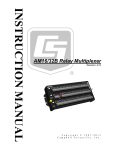
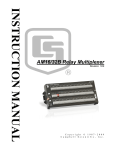
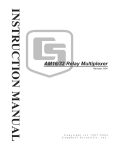
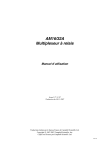
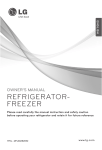
![2 Appuyez sur la touche [OK].](http://vs1.manualzilla.com/store/data/006390790_1-bc76b5eeca6bb9eb269e6d2802379648-150x150.png)

